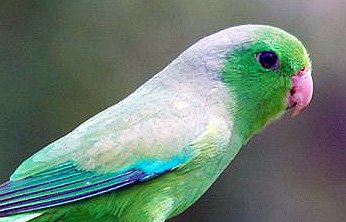|
Green-rumped
Parrotlet
Care And Information
As Pets:
Sweet and playful. Can become possessive of toys and
people. Novel items may alarm them, so slow introduction
of new toys is essential.
Captive Status:
Becoming more common.
Longevity:
25 yrs
Housing:
Outdoor or indoor enclosure, minimum length 1.2m (4 ft).
Diet:
Pelleted diet, supplemented with calcium (via cuttlebone
or drops); fruits such as: apple, pear, orange, banana,
kiwi, pomegranate, etc; vegetables such as: carrot,
corn, celery, peas in the pod, green beans and green
leaves; seed mix including: millet, safflower,
buckwheat, oats and limited sunflower; millet spray;
seed grasses where available.
Enrichment:
Bathing, socialization, swings, ropes, bird-safe chew toys (with pine or fir wood, or vegetable tanned
leather), puzzle toys, foraging items.
Nest Box Size:
Vertical box, 6″ x 6″ x 6″ (15cm x 15cm x 15cm).
Clutch Size:
5 or 6
Incubation Time:
20-22 days
Fledging Age:
5 weeks

|
Parrotlet Food, Diet LuckyFeathers:
We feed each Green rumped Parrotlet a high quality cockatiel seed mixed with low sunflower count. Also we mix in a high quality pellet food. Parrotlets are recommended to have both seed and pellets as a daily diet. Sunflower seeds are a great source of vitamins and fatty acids that Parrotlets need. However you must watch your bird and make sure it is not eating the sunflower seeds only. Many parrots like the sunflower seeds so well that they eat nothing else. If you find that your Green rumped Parrotlet is doing this, try to leave the seed in for a longer period of time before changing it. Many times this will cause the bird to eat the rest of the seed mix after it has picked out all of the sunflowers. We also use and recommend a liquid bird vitamin that can be added to the birds water. If you are feeding your Green rumped Parrotlet pellets or a seed pellet mix, we do not recommend vitamins on a daily basis. The pellets are loaded with vitamins so only give your bird liquid vitamins once or twice a week. A diet with to much vitamin content can cause your Parrotlet to get ill or have health issues. Twice a week our birds get one of the below treat meals or some kind of fruit or vegie.
Harmful Foods:
This is a short list of harmful foods for birds, obviously there are other items and you need to do your homework before you share.
Chocolate
Apple Seeds
Avocado or Guacamole
Onions
Alcohol
Mushrooms
Tomato Leaves
Salt
Caffeine (in any form)
Dried Beans (Cooked Beans Are Safe)
Any High Fat Food
Whole cereals and whole grains: spray millet, amaranth, barley, couscous, flax, whole-grain pastas, oat, quinoa (truly a fruit but used as a cereal), whole-wheat, wild rice, whole rices.
Edible flowers:
carnations, chamomille, chives, dandelion, daylily, eucalyptus, fruit tree blossoms, herb blossoms, hibiscus, honeysuckle, impatiens, lilac, nasturtiums, pansies, passion flower (Passiflora), roses, sunflowers,
tulips, violets.
Note: that the leaves of some of these plants are poisonous to parrots.
Greens and/or weeds:
mainly ; bok-choi, broccoli and/or cauliflower leaves, cabbage leaves, collard greens, dandelion leaves, kelp, mustard leaves, seaweeds, spirulina, water cress. occasionally amaranth leaves, beet leaves, carambola (starfruit), chard, parsley, spinach & turnip leaves. All of these feature high oxalic acid contents that induces
production of calcium oxalates (crystals/stones) by binding calcium and other trace minerals present in foods and goods with which they’re ingested, possibly leading to calcium deficiencies and/or Hypocalcemia in
minor cases, liver or other internal organ damage or failure in more severe cases.
Fruit
(except avocados which are toxic): all apple varieties, banana, all berry varieties, all citrus varieties, grapes, kiwi, mango, melons, nectarine, papaya, peach, all pear varieties, plum, star-fruit. Pits and seeds from every citrus and drupe species must always be discarded as they are intoxicating. However, achenes and tiny seeds from pseudo and true berries (bananas, blueberries, elderberries, eggplants, persimmons, pomegranates, raspberries, strawberries, tomatoes) are all acceptable.
Legumes: almonds, beans, lentils, peas, nuts and tofu.
Grain and/or Legume sprouts:
adzuki beans, alfalfa beans, buckwheat, lentils, mung beans, pinto beans, red kidney beans, sesame seeds, sunflower seeds. Caution with only lima bean and navy bean sprouts which are toxic. Red kidney beans must be thoroughly cooked, as uncooked red kidney beans are toxic.
Vegetables: (except uncooked potatoes, uncooked onions and all mushrooms): beet, broccoli, cauliflower, carrots, cucumber, all cabbage varieties, fresh beans, fresh romane lettuce, fresh peas, parsnip, all pepper varieties, all squash varieties, sweet potatoes, tomato, turnip, yams, zucchini. Pellets: specifically formulated for small tropical Parrot species. Other fat-free, healthy and nutritious human foods. Adding these foods provides additional nutrients and can prevent obesity and lipomas, as can substituting millet, which is relatively low in fat, for higher-fat seed mixes. Adult parrotlets often do not always adapt readily to dietary additions, so care must be taken to introduce healthy diets as young as possible (ideally weaned onto fresh foods before introducing chicks onto seeds). Parrotlets like other Parrots learn mainly by mimicry and thus most adult parrotlets will be easily encouraged to try new foods by observing another bird eating the food, or by placing the new food on a mirror. Parrot species (including Parrotlets) are herbivores. Consequently, they should be fed vegetarian diets that are ideally supplemented with vegetal proteins. Produced by the combination of any type of whole grain/cereal with any type of legume/pulse. Eggs (hard-boiled and/or scrambled) are the only appropriately healthy source of animal proteins. Mostly for birds in either breeding, growing, moulting and/or recovering conditions. High levels of proteins (most particularly animal proteins) is unhealthy for Parrotlets and any other Parrot species living under any alternate conditions (i.e. non-breeding, pets).
|